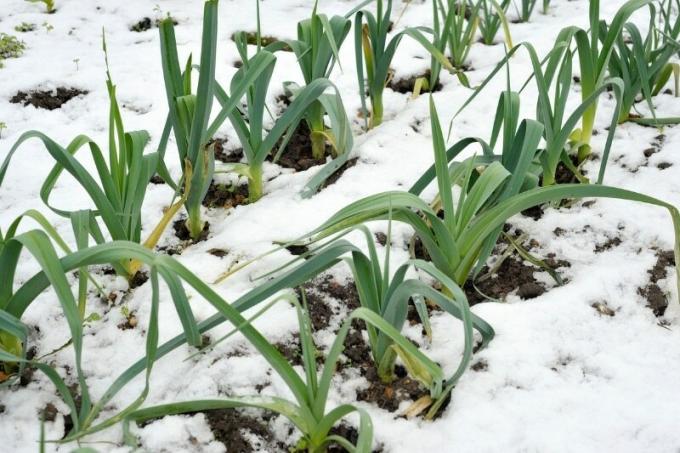
The leek grows and grows, the stem increases in size. But apart from that, there are no characteristics that clearly indicate harvest maturity. The harvest time for leeks can still be determined easily. Read here when you can harvest the vegetables.
To the point
- Harvest time varies depending on the species and variety
- Summer leek: from July to the end of August, can sprout again
- Autumn leek: from early September to December
- Winter leek: from December to May of the following year, on frost-free days
- Year-round harvest possible by combining the three types
Table of contents
- It depends on the variety
- Harvest time for summer leeks
- Harvest time for autumn leeks
- Harvest time for winter leeks
- Harvest leeks all year round
- frequently asked Questions
It depends on the variety
In this country, different types of leek (Allium porrum) can be grown. The differences don't just relate to the appearance and taste of the bars. It's also about when during a gardening year a particular variety grows best. Accordingly, the sowing time of the leek varies and, based on this, also the harvest time
. The leek varieties are divided into three groups:- Summer leeks
- Autumn leeks
- Winter leeks

So that you can harvest really thick leek stalks at harvest time, you have to use every variety plant at the optimal time:
- Summer leeks: early to mid-April
- Autumn leek: end of May to mid-June
- Winter leek: July to mid-August
Tip: Summer leeks can be grown on the windowsill or in the greenhouse from January and autumn leeks from February to the end of April.
Harvest time for summer leeks
The leek harvest season begins from the beginning of July, because early summer leek varieties are ready to harvest. You can harvest late varieties from around the end of August. Since the harvest times of the different summer leek varieties can be several weeks apart, you should find out about the variety-specific harvest times. These are usually printed on the back of the seed bags.

Tip: The leek is usually pulled from the bed with the roots. However, if you cut the summer leek close to the ground and leave the rhizome in the ground, it will sprout again over the course of the summer. The second shoot is also edible, but will be a little thinner.
Harvest time for autumn leeks
The harvest time for autumn leeks is long enough from early September to December. Here too, the start of the harvest can vary slightly depending on the variety or the weather.
Tip: The diameter of the leek is also a good indication of harvest maturity. It should be at least 3 to 4 cm. Therefore, start the harvest with the thickest stalks, while the thinner stalks remain in the bed and can grow in size.
Harvest time for winter leeks
Winter leeks offer the longest harvest season. Its harvest time starts in December and runs until May of the following year. This means: The winter leek can be harvested continuously as needed. The only thing to make sure is that the ground is not frozen.

Do you need the bed to be replanted before all the leek stalks have been harvested? Then dig up the leeks and place them in a cold frame. In a protected location it will survive the winter undamaged, just like in a bed. Alternatively, you can hammer the poles into moist sand or soil and in a damp, cool basement keep fresh all winter long.
Harvest leeks all year round
If you have enough space in the garden, combine summer, autumn and winter leeks. The harvest times of the three types flow seamlessly into one another, so you will no longer have any gaps in your harvest.
frequently asked Questions
The entire stick is edible, both the white and the green part. The leaf pieces that spread out laterally at the tip of the stalk are just as edible and aromatic. The leek roots are also edible. The so-called beard, after being thoroughly cleaned of soil residues, can be fried into a crispy, attractive and edible decoration.
Yes, shot leeks are still edible. There is no need to worry about any toxic substances. Even the leek flower is edible and a particularly attractive eye-catcher on the plate.
Leeks, especially summer leeks, can be allowed to grow back. Even if the plant finds enough nutrients in the bed, there will hardly be a third or even fourth usable sprout. The time available for growth is limited due to the weather. In addition, leek is only a biennial plant.
The green color comes from light. Hill your leek plants early and repeatedly to block light. Alternatively, you can put a dark, sufficiently wide plastic tube over each leek stick.



